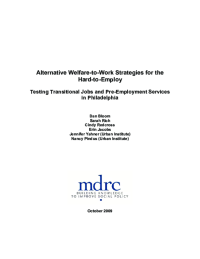Alternative Welfare-to-Work Strategies for the Hard-to-Employ
Testing Transitional Jobs and Pre-Employment Services in Philadelphia
As welfare caseloads have declined over the past decade, policymakers and administrators have focused increasingly on long-term and hard-to-employ recipients who have not made a stable transition from welfare to work. Many of these recipients face serious barriers to employment such as physical and mental health problems, substance abuse, and limited work and educational backgrounds.
This report presents interim results from an evaluation of two different welfare-to-work strategies for hard-to-employ recipients of Temporary Assistance for Needy Families (TANF) in Philadelphia. The study is part of the Enhanced Services for the Hard-to-Employ Demonstration and Evaluation Project, which is testing innovative employment strategies for groups facing serious obstacles to finding and keeping a steady job. The project is sponsored by the Administration for Children and Families and the Office of the Assistant Secretary for Planning and Evaluation in the U.S. Department of Health and Human Services (HHS), with additional funding from the U.S. Department of Labor. It is being conducted by MDRC, a nonprofit, nonpartisan research organization, along with the Urban Institute and other partners.
The first approach being tested is a transitional jobs model operated by the Transitional Work Corporation (TWC). TWC quickly places participants into temporary, subsidized jobs; provides work-related supports; and then, building on this work experience, helps participants look for permanent jobs. The second model, called Success Through Employment Preparation (STEP), aims to assess and address participants’ barriers to employment — such as health problems or inadequate skills — before they go to work.
The evaluation uses a rigorous design in which nearly 2,000 long-term and potential long-term welfare (TANF) recipients were assigned at random to TWC or STEP, or to a control group that did not participate in either program. The research team is following all three groups over time using surveys and administrative data. Results for the first 18 months show that:
- The TWC program group members had significantly higher employment rates and earnings than the control group members, but the difference faded after the first year of follow-up. When earnings from transitional jobs and unsubsidized jobs are combined, the TWC group earned about $1,000 (26 percent) more than the control group, on average, and received significantly less welfare assistance. The earnings gains and welfare reductions largely offset one another, however, leaving the two groups with about the same total income.
- Recipients who were assigned to the STEP program did not work or earn more, or receive less welfare, than the control group. The results may have been affected by the fact that many people who were assigned to STEP did not participate in the program for long periods.
A later report will present results over a three-year period, but these interim results suggest some fairly clear patterns. The TWC program substantially increased employment in the short term, but this and other studies suggest that, in order to sustain impacts, transitional job programs need to help more people obtain and retain permanent jobs. The STEP program has not increased employment so far, adding to a growing body of evidence suggesting that it can be difficult to engage welfare recipients in extensive pre-employment services long enough to significantly improve their employability.






